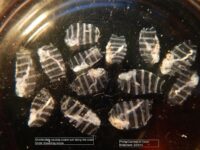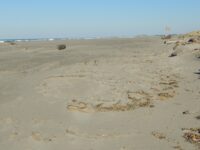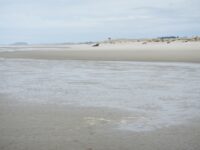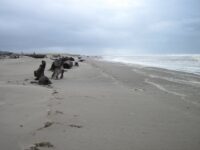Mile 96 Report
Bandon State Park, west of Twomile Creek
May 31, 2009
Jogged and walked miles 94, 95 and part of 96.
Report Details
Jogged and walked miles 94, 95 and part of 96. Saw sandpipers, Harbor Seals swimming in the ocean and in the outlet to New River, river otters swimming in the outlet to New River and a large sea lion. Only other human was on ATV with USDA markings. Signs, posts and one cage for snowy plovers recently installed. Evidence of wave overtopping. Driftline included hundreds of different-sized jellies starting in Mile 95 but majority found in Mile 96, crab body parts, mussels, oyster shells, four types of seaweed and lots of plastic. Removed wood crate and two floats from the beach.
Conditions
Temperature: 55 F. Cloud Cover: Cloudy. Wind Velocity: Calm/Light. Tide Level: 3.0 feet.
Human Activities
Number of people: 2. Number of dogs: 1. Walking or running: 2. Playing in surf: 1. Playing in sand: 1. Other Activities: 1. One ATC with USDA marking, my dog and I accidentally crossed from the New River (where there was no posting) thru a plover area with posts facing the ocean.
Concerns
Litter, People/dogs/vehicles in closure areas
Apparent violations: I accidentally crossed from the New River to the beach thru a plover area..Disturbances: Disturbance/harassment of marine mammals, Shorebirds moving in response to humans/dogs
Vehicles
Notable Wildlife
Big seal, other seals, otters, various birds including sand pipers.
Dead Fish or Invertebrates
Dungeness crabs, mussel and oyster shells, on other crestacean
Driftline Content
Seaweeds and seagrass, Animal casings (e.g., crab, shrimp molt), Shells, Small rocks. Two styrofoam floats, one wood crate, lots of plastic
Man-made Modifications
ew signs and one cage for plovers
Natural Changes
Evidence of wave overtopping.
Actions & Comments
I took out the wood crate and two floats.Beach walk, Sunday morning, May 31st, 2009 [This walk included all of what I think is mile 94 as well as mile 95 and part of 96. I report on all these as it appears no one else has lately and because of the interesting wildlife I saw in what I think was mile 96.]LucieAnne and I rowed down the Lower Fourmile Creek and across the New River. We beached our dingy, the Second Sea Sprite, a little after nine-thirty under overcast skies with clouds reaching from the coastal hills to the watery, pelagic horizon while enjoying the absolutely calm air. Temperature was mild, perhaps in the fifties. My shorts and a seatshirt were sufficient. We climbed over the dunes which do seem higher than they used to be with more European beach grass anchoring the sand and providing shelter for a variety of other vegetation including one specie with pretty blue flowers. I saw what I took to be the eroded tracks Blaine and Lucie and I had left on Tuesday. The waves were larger than on my previous visits, three feet crest to trough in some places and we did see some handsome five and six footers as we made our way north. However they were very small, two feet or less when we reached our destination at the mouth of the New River some three miles from our starting point. When we arrived the ocean was green rather than the blue it displays under sunny skies, but was grey when we returned southward. I don’t recall seeing any ships on it inspite of the clement weather. The visibility was even better than on my visit Tuesday. The rocks to the north and Cape Blanco to the south were so clear and distinct under the grey sky that I wondered if they could really be eight miles and twelve miles away. There were a lot of plastic bottles and a piece of black ABS pipe on the beach near the dunes, more than I have noticed on previous visits. I spend nearly all my jogs on the firm wet sand near the surf line where the beach is usually completely clean of flotsam and jetsam. Within a hundred yards we saw new signs and a little past that a large structure of wire mesh, perhaps four feet on a side and three feet tall that I took to be protection for a snowy plover nesting site. They weren’t there on Memorial Day weekend. I did not notice any more such enclosures, but there were more signs and posts with messages regarding the snowy plovers as we went further. Later we saw some tire tracks so widely spaced that they were more likely made by a dune buggy rather than the more common ATV. There were lots of big footprints in the dry sand there, and it appeared they all had something to do with the placement of signs saying, “No entry beyond this point” due to the snowy plovers’ habitat.We jogged north, the waves approached the beach perpendicularly from the west. It appeared the tide was very low altho’ my reading of the tide table indicates it was still going out as the next low wouldn’t occur until nearly one in the afternoon. There were patches of darker course sand measuring fifty yards or more in length, sometimes right near the surf and sometimes up where the slope of the sand becomes more horizontal. Initially I was concerned as we didn’t see any birds but after five or ten minutes a flock of ten to twenty birds went by, flying north and very low, just inches above the smooth swells beyond the surf line and were passed by a small solitary dark bird winging south. As we continued I saw a bevy of sandpipers, the first I can recall seeing, on the dry sand. Later, as we returned southward I watched a dozen birds wheel and turn from their northward course and one or two dove into the water out beyond the surf and the whole flock settled down in the water, I assume to fish. We also saw common white gulls standing on or flying over the sand while we made our way north. Part way to our destination I spotted a wooden crate up on the dry sand and near it a grey rock, of sedimentary origin judging from the stripes or layers. It sported semihemisperical depressions in its surface. These rocks are fairy common on our beach and a little latter I learned how they are formed. At one point we found odd holes, about a dozen, in the wet sand near the surf, a couple of inches deep and about the same across. There were some marks in the surrounding sand but I could not identify them as bird tracks. I haven’t seen anything like that before. A bit further along I found some small grey crustaceans shaped like fleas but between one and two inches long. All were dead and I counted eight legs, so I quess they are more closely related to spiders than insects, with the hindmost pair large and wider than the others. I don’t recall seeing them before, but I also hadn’t been this far north in several years, nor on the beach in May before this Spring. Meanwhile out beyond the surf I spied first one and later more dark shapes appearing and disappearing. I don’t think they were inanimate and took them to be seals. This was borne out when, after we had gone around two miles, a seal was swimming in the surf. It seemed curious about us and followed us northward, appearing and disappearing under the waves, ducking under each time one broke over its head. At the closest it was only fifty feet away, and I could clearly see its eyes and nose but couldn’t see any external ears. Its face was dark grey and its head about the size and shape of a fairly large dog. When we got to within a few hundred yards of the outlet of the New River there were several, at least two or three, hard to tell as they kept appearing and disappearing and I don’t know how far or fast they were traveling under the water, little mammalian heads, a bit bigger than a man’s fist. I think they were sea otters as they were much smaller than the seal but about as close. I didn’t realize sea otters lived along this part of the desolate Oregon coast. I was probably somewhere in mile 96 north of the California border. They did not assume the floating-on-their-backs-with-their-bellies-in-the-air posture that would have convinced me they were indeed sea otters. (I have observed what appear to be slides made by river otters along the south bank of the Lower Fourmile Creek in past Summers.)As we had proceeded north I saw several nearly whole crab carcasses of the Dungeness variety and more and more crab parts and shells as we went by the close-in seal and the otters. I wonder if there is a connection between the mammals and the dead crustaceans. I did spot my first jelly since our arrival in early May and later hundreds upon hundreds of them, one was as big as a baseball and another the size of a softball. And there was one so clear and transparent it looked like an optical lens. Most where around the size of a silver dollar. There were also oyster shells, some with barnacle shells attached, and mussel shells. I saw four types of seaweed. The kelp was rare (just two small clumps) and desiccated, yellowed by the sun. One type of seaweed I don’t recall noticing previously consisted of a single slender round strand, about a yard long and green. I only saw two or three of these. Meanwhile, altho’ there are no places were the ocean had breeched the dunes recently in mile 94, there were increasing breaches as we proceed onto miles ninety-five and then ninety-six. The last perhaps half mile leading to the mouth of the New River is without dunes (or European beach grass) and here there is just nearly flat sand between the surf and the river. As we approached the New River’s terminus I could see a dark object in the surf and wondered if it was an off-shore rock. But when we got closer, and after I had been distracted by the otters, the black mound was gone. I wondered what it had been as we turned East to follow the New River. I looked back and saw a large pinniped sitting completely out of the water on a sand bar just a little off shore. I took two pictures and it humped its back and teeter-tottered on first its front then hind flippers awakwardly across the sand bar and slid gracefully into the water. It is the first time I have seen the full body of one of these creatures alive anywhere along our beach. I suspect it was a seal and it looked like it weighed between two and four hundred pounds. The area where the New River runs into the sea is all sand and the river, just thirty or forty feet wide, runs down hill in ripples of clear water across the beach. There is no vegetation there. It looked to me that LucieAnne, on her short bassett hound legs, could probably wade across. There was no vegetation in the fresh water either, unlike where we had rowed across, where the bottom is thick with some sort of soft green plants in long furry streamers. I was struck by how warm the river water was. It would be quite comfortable for swimming. Since the local air temperatures have not exceeded seventy recently, I wondered if the water originated further inland where it has been hot and had borne the heat all the way to the refreshingly cool ocean. The sand had been pretty cool under foot the whole way. (I always jog or walk the beach barefoot.) Following the suggestion my wife had made on an earlier visit Lucie and I walked south along the west bank of the New River (which I call Far Rockaway). We waded across some branches of the river where the bed consisted of yellow-orange sand stone pitted with semicircular holes made by stones swirling around within them, driven by the current. I have seen similar but much larger holes, some big enough to serve as a tub, made in granite in the high country along Little Yosemite Creek. We found several deep spots, three or four feet, that looked like they would be enjoyable swimming holes. I did see some somewhat obscured prints which where either left by a large deer or possibly an elk. We did once find a long line of tracks left by a single elk on that west bank last Summer. There were posts demarking more snowy plover habitat on the bank above the river. We went far enough south that they stopped and crossed the sand back to the ocean just north of the first large dune. Unfortunately when we did we found more of the posts facing the ocean but, fortunately, we did not see any signs of the plovers. On our way back I retrieved that wooden crate and two brightly colored Styrofoam floats and that interesting sedimentary rock as well as two crab shells, several tiny mollusk shells and a few other rocks that had caught my fancy. As I was walking along, thus laden, an ATV approached from the south. It was driven by a young man, also using the firm sand near the surf, and he slowed to greet us briefly. The large wood box on the front of his vehicle bore the initials USDA (US Department of Agriculture?) and two other letters I have forgotten. I did not see any long gun so I am not sure if he is the predator control guy or not. Lucie went for a swim and did not come when I called so I could put her into the boat. She wound up swimming across the river and up the creek nearly half way to where we usually dock. We got back to the Lonely Plover (our house) shortly after noon.
All Mile 96 Reports
Mile 96
Bandon State Park, west of Twomile Creek
Report from Diane and Dave BilderbackHere on the south coast, we have been having a wash up of a pelagic purple tunicate, Dolioletta gegenbauri, that at times causes a deep purple wash on the beach and also has colored small sand pools.
Volunteer Trainer
Mile 96
Bandon State Park, west of Twomile Creek
A nearly nonexistent driftline with just a few small rocks.
D Bilderback
Mile 96
Bandon State Park, west of Twomile Creek
Shells, small rocks, pieces of jellies, broken Sand Dollars, a few Hydrozoa, Pleurobrachia Ctenophores, Phyllospadix, surfgrass, one stickleback fish and Porphyra in the driftline.
D Bilderback
Mile 96
Bandon State Park, west of Twomile Creek
Sparse driftline of small rocks, a few shells and broken Sand Dollars.
D Bilderback
Mile 96
Bandon State Park, west of Twomile Creek
European Dunegrass dominated the driftline with a few Bull Kelp and Sea Palm.
D Bilderback
Mile 96
Bandon State Park, west of Twomile Creek
Shells, rocks, a few kelp/algae, green phytoplankton scum, broken Sand Dollars, crab carapaces and Ctenophores in driftline.
D Bilderback
Mile 96
Bandon State Park, west of Twomile Creek
Light driftline of many Ctenophores, small rocks and a few shells and crab carapaces.
D Bilderback
Mile 96
Bandon State Park, west of Twomile Creek
Light driftline with fresh water aquatic plants- Myriophyllum (Water Milfoil), terrestrial plant debris-stems, leaves and needles and saltwater plants, Phyllospadix (Surfgrass)and Eelgrass, Zostera.
D Bilderback





